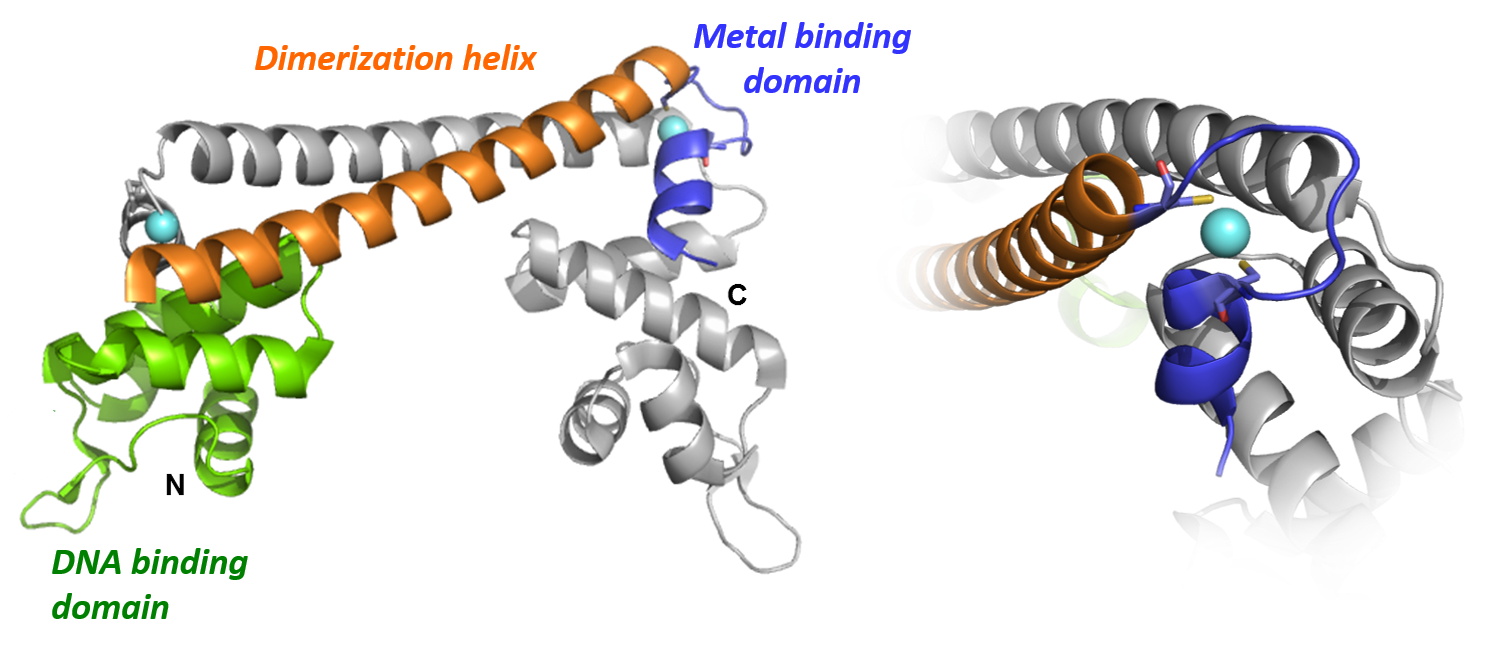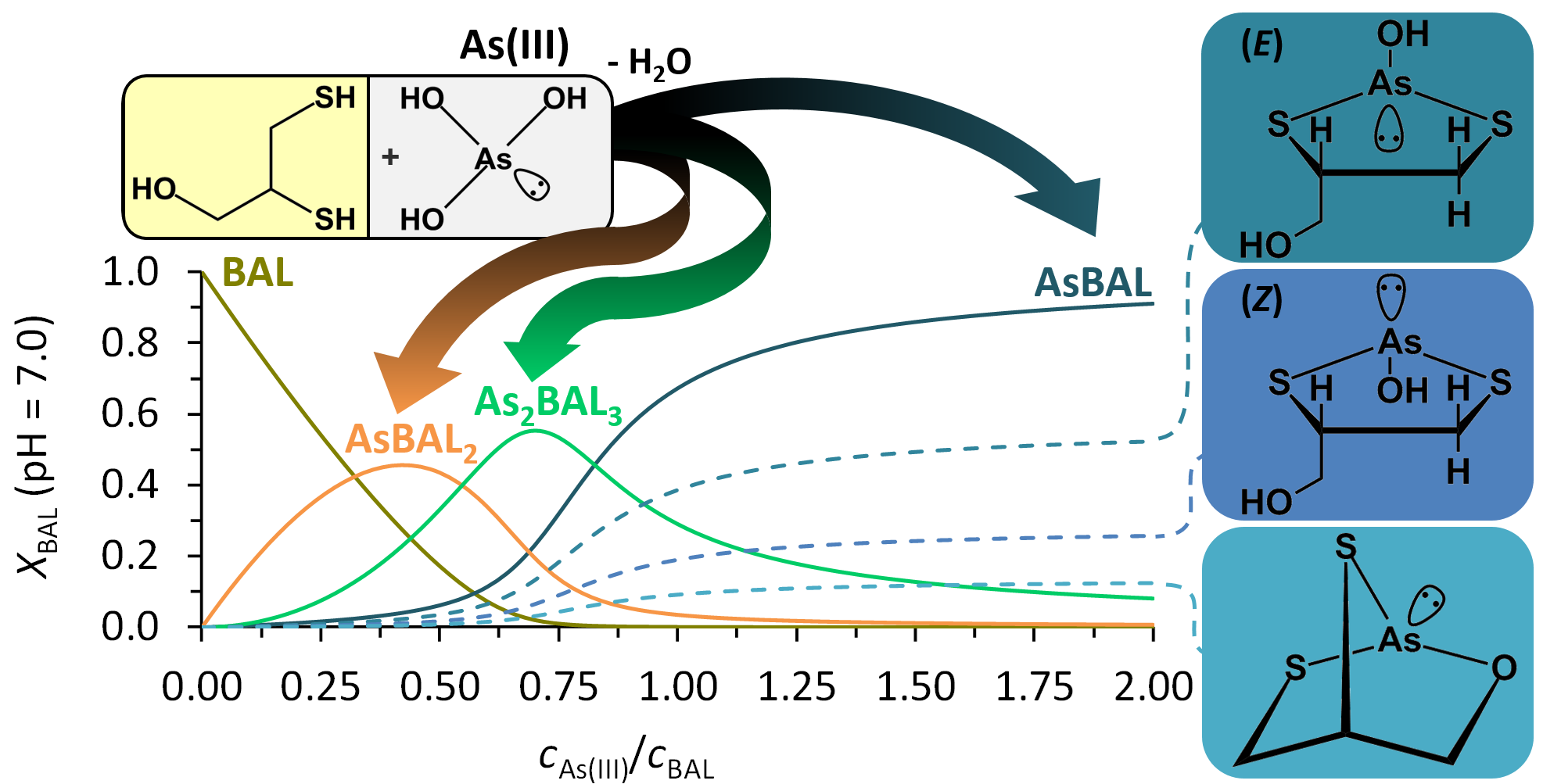Artificial Matalloproteins Project
Department of Inorganic and Analytical Chemistry
Bioinorganic Chemistry Research Group
Design of artificial nucleases
 Duchenne muscular dystrophy is a monogenetic disease, caused by the error of one single gene. Gene errors of this type are not recognised by the repair mechanisms of the organism, but they can be made „visible” and corrected in the presence of an appropriate template. To cleave DNA at a specific side artificial nucleases (hydrolizing enzymes) are designed, but they appeared to be toxic so far. The aim of our research group is to design a new safe artificial nuclease using the nuclease domain of the protein colicin E7. There is a part of this protein far in the sequence but sterically near to the active center, which is essential for the nuclease activity. This can provide basis to an allosteric regulation, however this is not clearly known yet. Accordingly our research is addressed to the following questions: - Study of the possibility of allosteric regulation in the nuclease domain of colicin E7: mutations are introduced into the protein and the decrease in nuclease activity, change in DNA-binding ability and metal ion binding is investigated by several methods. - Interconnection of the nonspecific nuclease colicin E7 to specific DNA-binding proteins: our goal is the construction of a safe artificial nuclease. The new nucleases will bind DNA at a specific side according to their design. Zinc finger, TALE of other DNA-binding proteins will be responsible for the specific binding and the nuclease domain of colicin E7 will cleave the DNA.
Duchenne muscular dystrophy is a monogenetic disease, caused by the error of one single gene. Gene errors of this type are not recognised by the repair mechanisms of the organism, but they can be made „visible” and corrected in the presence of an appropriate template. To cleave DNA at a specific side artificial nucleases (hydrolizing enzymes) are designed, but they appeared to be toxic so far. The aim of our research group is to design a new safe artificial nuclease using the nuclease domain of the protein colicin E7. There is a part of this protein far in the sequence but sterically near to the active center, which is essential for the nuclease activity. This can provide basis to an allosteric regulation, however this is not clearly known yet. Accordingly our research is addressed to the following questions: - Study of the possibility of allosteric regulation in the nuclease domain of colicin E7: mutations are introduced into the protein and the decrease in nuclease activity, change in DNA-binding ability and metal ion binding is investigated by several methods. - Interconnection of the nonspecific nuclease colicin E7 to specific DNA-binding proteins: our goal is the construction of a safe artificial nuclease. The new nucleases will bind DNA at a specific side according to their design. Zinc finger, TALE of other DNA-binding proteins will be responsible for the specific binding and the nuclease domain of colicin E7 will cleave the DNA.
Metalloregulatory proteins
 Many metal ions, including transition metal ions play important roles in biochemical processes. There are others, however, that are toxic for all living organisms. Even the essential metal ions can induce adverse effects when their concentration exceeds an optimal concentration range. It is essential for all living organisms to control the concentration of metal ions and to operate detoxification systems against the toxic constituents. The homeostatic metal ion balance is ensured by the ensemble of various transportation, transformation, storage and regulation processes. Metal ion sensing regulatory proteins, operating at the level of genetic transcription, play a fundamental role in bacterial metal ion homeostasis. These metalloregulatory proteins respond to the change of metal ion concentration by inducing or repressing the expression of proteins that participate in processes that balance the level of the regulated metal ion. Our research focuses mainly on members of the large MerR and ArsR protein families, but most importantly our main goal is to better understand the metal ion selective mechanism of operation of the copper efflux regulator CueR. Our studies involve experiments on the metal ion interaction of model peptides inspired by the metal binding loops these metalloregulators, but also the investigation of the metal ion binding features of the native proteins and their carefully designed mutants. The metal ion regulating/sensing mechanisms of the studied proteins may also be exploited for the design of genetically modified bacteria that (over)produce fluorescent proteins in a metal-ion promoted event and thus may signal the presence or even the change of concentration of a specific metal ion.
Many metal ions, including transition metal ions play important roles in biochemical processes. There are others, however, that are toxic for all living organisms. Even the essential metal ions can induce adverse effects when their concentration exceeds an optimal concentration range. It is essential for all living organisms to control the concentration of metal ions and to operate detoxification systems against the toxic constituents. The homeostatic metal ion balance is ensured by the ensemble of various transportation, transformation, storage and regulation processes. Metal ion sensing regulatory proteins, operating at the level of genetic transcription, play a fundamental role in bacterial metal ion homeostasis. These metalloregulatory proteins respond to the change of metal ion concentration by inducing or repressing the expression of proteins that participate in processes that balance the level of the regulated metal ion. Our research focuses mainly on members of the large MerR and ArsR protein families, but most importantly our main goal is to better understand the metal ion selective mechanism of operation of the copper efflux regulator CueR. Our studies involve experiments on the metal ion interaction of model peptides inspired by the metal binding loops these metalloregulators, but also the investigation of the metal ion binding features of the native proteins and their carefully designed mutants. The metal ion regulating/sensing mechanisms of the studied proteins may also be exploited for the design of genetically modified bacteria that (over)produce fluorescent proteins in a metal-ion promoted event and thus may signal the presence or even the change of concentration of a specific metal ion.
Interaction of AsIII (and SbIII) with thiol ligands: biospeciation, biochemical effects, chelator development
 Arsenic is known to exert severe biological effects on cells and tissues depending on the level and duration of exposure. As an interesting contrast arsenic and its derivatives have been applied, since the ancient times, as therapeutic agents e.g. in the treatment of ulcers, plague or malaria. Most significantly, arsenic trioxide (As2O3) has been shown to possess important antitumor properties against human acute promyelocytic leukemia (APL). It was suggested that similar mechanisms may operate both in the therapeutic and toxic activities of arsenic, nevertheless, the molecular details of these mechanisms are yet to be explored. It is well known, that arsenic, in its trivalent oxidation state, can bind to reduced thiols, especially when more thiol groups are available, and this plays a role in many of its physiological effects. Nevertheless, solution speciation studies on the systems of AsIII and small multithiol ligands are scarce in the literature, even though understanding the AsIII-thiol interaction at the level of small models could be essential in unravelling the versatile, sometimes paradoxical biological effects. With an aim of exploring the possible binding site and coordination environment preferences of AsIII in biological milieu we investigate the interactions of arsenous acid (H3AsO3 - the typical aqueous form of AsIII) with several thiol ligands, including heavy metal ion chelators and peptides.
Arsenic is known to exert severe biological effects on cells and tissues depending on the level and duration of exposure. As an interesting contrast arsenic and its derivatives have been applied, since the ancient times, as therapeutic agents e.g. in the treatment of ulcers, plague or malaria. Most significantly, arsenic trioxide (As2O3) has been shown to possess important antitumor properties against human acute promyelocytic leukemia (APL). It was suggested that similar mechanisms may operate both in the therapeutic and toxic activities of arsenic, nevertheless, the molecular details of these mechanisms are yet to be explored. It is well known, that arsenic, in its trivalent oxidation state, can bind to reduced thiols, especially when more thiol groups are available, and this plays a role in many of its physiological effects. Nevertheless, solution speciation studies on the systems of AsIII and small multithiol ligands are scarce in the literature, even though understanding the AsIII-thiol interaction at the level of small models could be essential in unravelling the versatile, sometimes paradoxical biological effects. With an aim of exploring the possible binding site and coordination environment preferences of AsIII in biological milieu we investigate the interactions of arsenous acid (H3AsO3 - the typical aqueous form of AsIII) with several thiol ligands, including heavy metal ion chelators and peptides.
Peptides as potential metal ion sensors
 Heavy metal ions appear in the environment from natural or anthropogenic sources and present a hazard to all living organisms. The development of novel methods that allow the sensitive, fast, simple, sometimes even on-site determination of such contaminants, and thus being real alternatives to the robust, lab-based instrumental techniques, is in the focus of environmental/(bio)analytical research. Our research aims at the design and investigation of oligopeptides with efficient toxic (semi)metal ion binding abilities that may potentially act as metal ion receptors in optochemical sensors. The sequences of these ligands have been inspired by the metal ion binding sites of various metalloproteins with transport, chaperone or regulatory functions. The ligands are synthesized with fluorophore labels allowing the optical detection of metal ion binding. Besides, we are also aiming at the synthesis and investigation of such molecular probes in their immobilized, solid-supported forms (attached to a resin, glass or quartz surface).
Heavy metal ions appear in the environment from natural or anthropogenic sources and present a hazard to all living organisms. The development of novel methods that allow the sensitive, fast, simple, sometimes even on-site determination of such contaminants, and thus being real alternatives to the robust, lab-based instrumental techniques, is in the focus of environmental/(bio)analytical research. Our research aims at the design and investigation of oligopeptides with efficient toxic (semi)metal ion binding abilities that may potentially act as metal ion receptors in optochemical sensors. The sequences of these ligands have been inspired by the metal ion binding sites of various metalloproteins with transport, chaperone or regulatory functions. The ligands are synthesized with fluorophore labels allowing the optical detection of metal ion binding. Besides, we are also aiming at the synthesis and investigation of such molecular probes in their immobilized, solid-supported forms (attached to a resin, glass or quartz surface).
